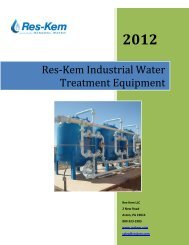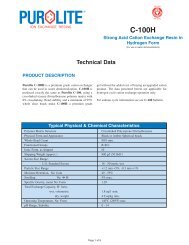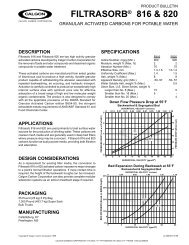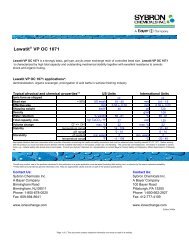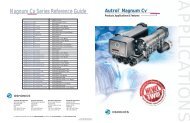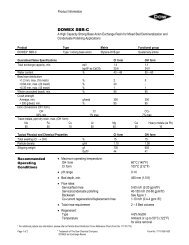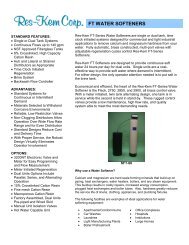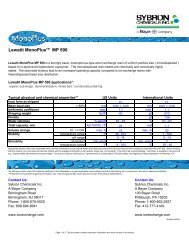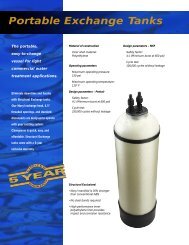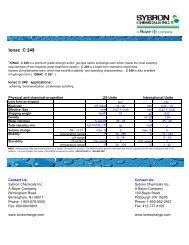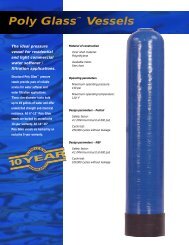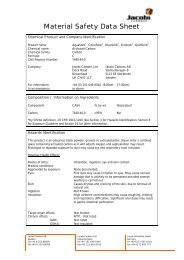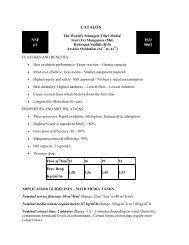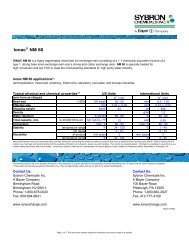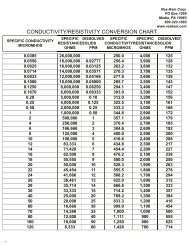DOWEX Ion Exchange Resins WATER CONDITIONING MANUAL
DOWEX Ion Exchange Resins WATER CONDITIONING MANUAL
DOWEX Ion Exchange Resins WATER CONDITIONING MANUAL
You also want an ePaper? Increase the reach of your titles
YUMPU automatically turns print PDFs into web optimized ePapers that Google loves.
Terms, Acronyms, And Abbreviations<br />
Term Definition<br />
Slow rinse Portion of the rinse that follows the regenerant solution and is passed through the ion<br />
exchange material at the same flow rate as the regenerant.<br />
Sluicing Method of transporting resin from one tank to another with water. Sluicing is usually used<br />
in mixed-bed deionization systems with external regeneration systems.<br />
Sodium form cation resin Cation exchange resin, regenerated with salt (NaCl). <strong>Exchange</strong>s sodium ions (Na + ) for<br />
metal cations (Mg 2+ , Ca 2+ , etc.), forming sodium salts (sulfates, carbonates, etc.).<br />
Sphericity Measure of the amount of ion exchange resin beads that are unbroken.<br />
Stability Capability of a resin to resist chemical and physical degradation.<br />
Stoichiometry Measure of the quantity of regenerant required compared to the resultant capacity of the<br />
ion exchange resin. This is expressed as a ratio of equivalents of regenerant to<br />
equivalents of capacity and is therefore >100%. It is the reciprocal of Regeneration<br />
efficiency.<br />
Stratified bed See Layered bed.<br />
Strong acid capacity Part of the total cation exchange capacity that is capable of converting neutral salts to<br />
their corresponding acids. Also referred to as Salt splitting capacity.<br />
Strong acid cation resin <strong>Resins</strong> employed in softening and deionization systems. When regenerated with salt, the<br />
sodium ions on the resin will effectively exchange for divalent cations such as calcium<br />
and magnesium. When regenerated with H2SO4 or HCl, the resin will split neutral salts,<br />
converting the salt to its corresponding acid. The resin usually receives its exchange<br />
capacity from sulfonic groups.<br />
Strong base anion resin <strong>Resins</strong> employed in chloride anion dealkalizers and deionization systems. When<br />
regenerated with salt, the chloride ions exchange for bicarbonate and sulfate anions.<br />
When regenerated with caustic soda, the resin removes both strong and weak acids<br />
from cation exchange resin effluent. The resin usually receives its exchange capacity<br />
from quaternary ammonium groups.<br />
Strong base capacity Part of the total anion exchange capacity capable of converting neutral salts to their<br />
corresponding bases. Also referred to as Salt splitting capacity.<br />
STY/DVB copolymer Polymer containing styrene (vinylbenzene) crosslinked with divinylbenzene.<br />
Sulfonic Term describing a specific group that imparts a strongly acidic exchange ability to some<br />
cation resins.<br />
Support media Graded-particle-size, high-density materials such as gravel, anthrafil, quartz, etc. Used to<br />
support the resin bed.<br />
Surface water Water taken directly from surface sources such as rivers, lakes, and seas.<br />
Swell Tendency of an ion exchange resin to expand or contract depending on the counterions<br />
associated with it.<br />
Tertiary ammonium Term describing a specific group that imparts a weakly basic exchange ability to some<br />
anion resins.<br />
Tertiary effluent Waste water from a municipal water-treatment plant that has undergone sedimentation,<br />
biological treatment, and advanced particle removal steps such as clarification and<br />
filtration. See also Waste water.<br />
Throughput Amount of product water generated during the service cycle.<br />
Total capacity Maximum exchange ability of an ion exchange resin expressed on a dry weight, wet<br />
weight, or wet volume basis.<br />
Train Single ion exchange system capable of producing the treated water desired, such as a<br />
strong acid cation resin bed followed by a strong base anion resin bed, with multiple<br />
trains being duplicates of the single system.<br />
Under drain Piping inside an ion exchange vessel that evenly collects the treated water after it has<br />
passed through the resin bed.<br />
<strong>DOWEX</strong> <strong>Ion</strong> <strong>Exchange</strong> <strong>Resins</strong> 15 Water Conditioning Manual



